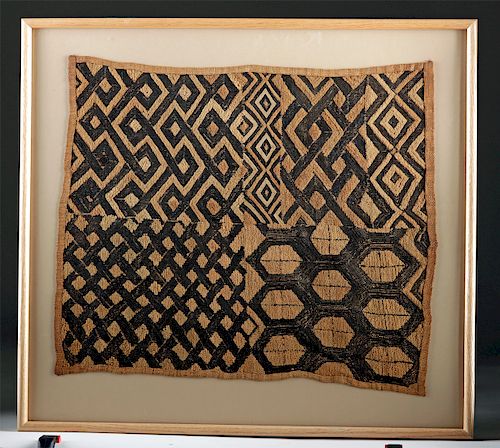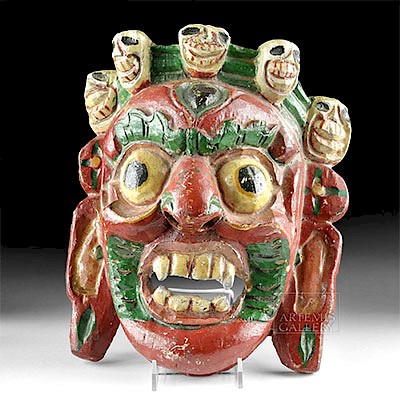Framed Mid-20th C. Kuba Cloth Textile
Lot 180c
About Seller
Artemis Gallery
686 S Taylor Ave, Ste 106
Louisville, CO 80027
United States
Selling antiquities, ancient and ethnographic art online since 1993, Artemis Gallery specializes in Classical Antiquities (Egyptian, Greek, Roman, Near Eastern), Asian, Pre-Columbian, African / Tribal / Oceanographic art. Our extensive inventory includes pottery, stone, metal, wood, glass and textil...Read more
Estimate:
$600 - $900
Absentee vs Live bid
Two ways to bid:
- Leave a max absentee bid and the platform will bid on your behalf up to your maximum bid during the live auction.
- Bid live during the auction and your bids will be submitted real-time to the auctioneer.
Bid Increments
| Price | Bid Increment |
|---|---|
| $0 | $25 |
| $300 | $50 |
| $1,000 | $100 |
| $2,000 | $250 |
| $5,000 | $500 |
| $10,000 | $1,000 |
| $20,000 | $2,500 |
| $50,000 | $5,000 |
| $100,000 | $10,000 |
| $200,000 | $20,000 |
About Auction
By Artemis Gallery
Apr 25, 2019
Set Reminder
2019-04-25 10:00:00
2019-04-25 10:00:00
America/New_York
Bidsquare
Bidsquare : Pre-Columbian | Tribal | Ethnographic
https://www.bidsquare.com/auctions/artemis-gallery/pre-columbian-tribal-ethnographic-4035
Featuring ancient and ethnographic art from around the world, including Pre-Columbian, Native American, African / Tribal, Ethnographic, Spanish Colonial, Fossils, Fine Art, much more. Artemis Gallery info@artemisgallery.com
Featuring ancient and ethnographic art from around the world, including Pre-Columbian, Native American, African / Tribal, Ethnographic, Spanish Colonial, Fossils, Fine Art, much more. Artemis Gallery info@artemisgallery.com
- Lot Description
Central Africa, Democratic Republic of the Congo, Kuba, ca. mid 20th century CE. A large Kuba cloth panel presenting bold geometric patterns in warm earth tones - chocolate brown against a creamy beige ground - set in a frame under glass. Traditionally, kuba cloth is woven from raffia-tree leaves; this example is comprised of naturally colored fabric created via a laborious process of hand-dyeing using mud, indigo, or the powdered bark of the camwood tree. Such cloths are usually created by Kuba men on a single heddle loom. Next, they are embroidered by women and children to create an uncut or cut-pile appearance (the latter resembling a velvet or velour texture). Kuba cloths are worn during ceremonial events, especially funerals; however, they are also found in tapestries and home furnishings. The abstract geometric patterns are symbolic of an individual's social and marital status, age, and/or personal attributes or character. Size: 23.5" W x 21" H (59.7 cm x 53.3 cm); 28.375" W x 26" H (72.1 cm x 66 cm) framed
"Phyllis Ross" is handwritten on a piece of blue tape on the verso. Phyllis Ross is a specialist in the history of 20th century design and decorative arts. Ross has curated exhibitions at the Museum of the City of New York and is the author of "Gilbert Rohde: Modern Design for Modern Living" (Yale University Press, 2009); Rhodes was an important American furniture designer of the 1930s and 1940s.
Provenance: private East Coast, USA collection; In addition, "Phyllis Ross" is handwritten on a piece of blue tape on the verso, suggesting that Ross may have owned or worked with this piece. Phyllis Ross is a specialist in the history of 20th century design and decorative arts.
All items legal to buy/sell under U.S. Statute covering cultural patrimony Code 2600, CHAPTER 14, and are guaranteed to be as described or your money back.
A Certificate of Authenticity will accompany all winning bids.
We ship worldwide and handle all shipping in-house for your convenience.
#140199Textile is framed under glass. It has not been examined outside the frame, but appears to be in very good condition. Phyllis Ross - a specialist in the history of 20th century design and decorative arts - is handwritten on tape on verso.Condition
- Shipping Info
-
All shipping is handled in-house for your convenience. Your invoice from Artemis Gallery will include shipping calculation instructions. If in doubt, please inquire BEFORE bidding for estimated shipping costs for individual items.
-
- Buyer's Premium



 EUR
EUR CAD
CAD AUD
AUD GBP
GBP MXN
MXN HKD
HKD CNY
CNY MYR
MYR SEK
SEK SGD
SGD CHF
CHF THB
THB















